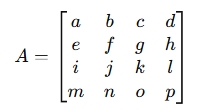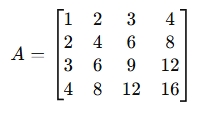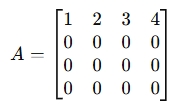Rank calculator for 4*4 third-order matrix
|
| |||||||||||||||||
| Results: | |||||||||||||||||
| |A|= | |||||||||||||||||
| Adjoint matrix Adj(A) = |
| ||||||||||||||||
| A-1 = |
| ||||||||||||||||
What is a Rank Calculator for a 4×4 Matrix?
A Rank Calculator for a 4×4 matrix is a tool used to compute the rank of a given 4×4 matrix. The rank of a matrix refers to the maximum number of linearly independent rows or columns in the matrix. The rank provides important information about the matrix's properties, including whether it has an inverse and whether it can be used to solve systems of equations.
For example, a 4×4 matrix:

The rank of matrix A is determined by performing row operations to transform the matrix into row echelon form (REF) or reduced row echelon form (RREF). The rank is the number of non-zero rows in the echelon form.
Why Use a 4×4 Matrix Rank Calculator?
- Linear Dependence – Determines if the rows or columns are linearly dependent or independent.
- System Solvability – The rank can indicate whether a system of linear equations has a unique solution, no solution, or infinitely many solutions.
- Matrix Properties – The rank helps identify whether the matrix is invertible (i.e., if its rank is equal to the number of rows or columns).
- Applications:
- Physics & Engineering – Used in force analysis, stability studies, and other system evaluations.
- Machine Learning & Data Science – Important for feature selection, dimensionality reduction, and matrix factorization.
- Economics & Statistics – Used in econometrics and regression models.
- Computer Graphics – For transformations and projections in 3D modeling.
How Does It Work?
- Input a 4×4 matrix.
- Perform row reduction to transform the matrix into row echelon form (REF) or reduced row echelon form (RREF).
- Count the number of non-zero rows. This number is the rank of the matrix.
Example Calculation
Given the matrix:

- Perform row reduction (Gaussian elimination):

- The number of non-zero rows is 1, so rank(A) = 1.
When to Use It?
- In solving systems of linear equations – Rank determines if a system has a unique solution or infinitely many solutions.
- In physics and engineering – To study the independence of systems, forces, or energies.
- In machine learning – To determine if features are linearly dependent or redundant in datasets.
- In 3D modeling and graphics – To ensure transformations and projections are independent.